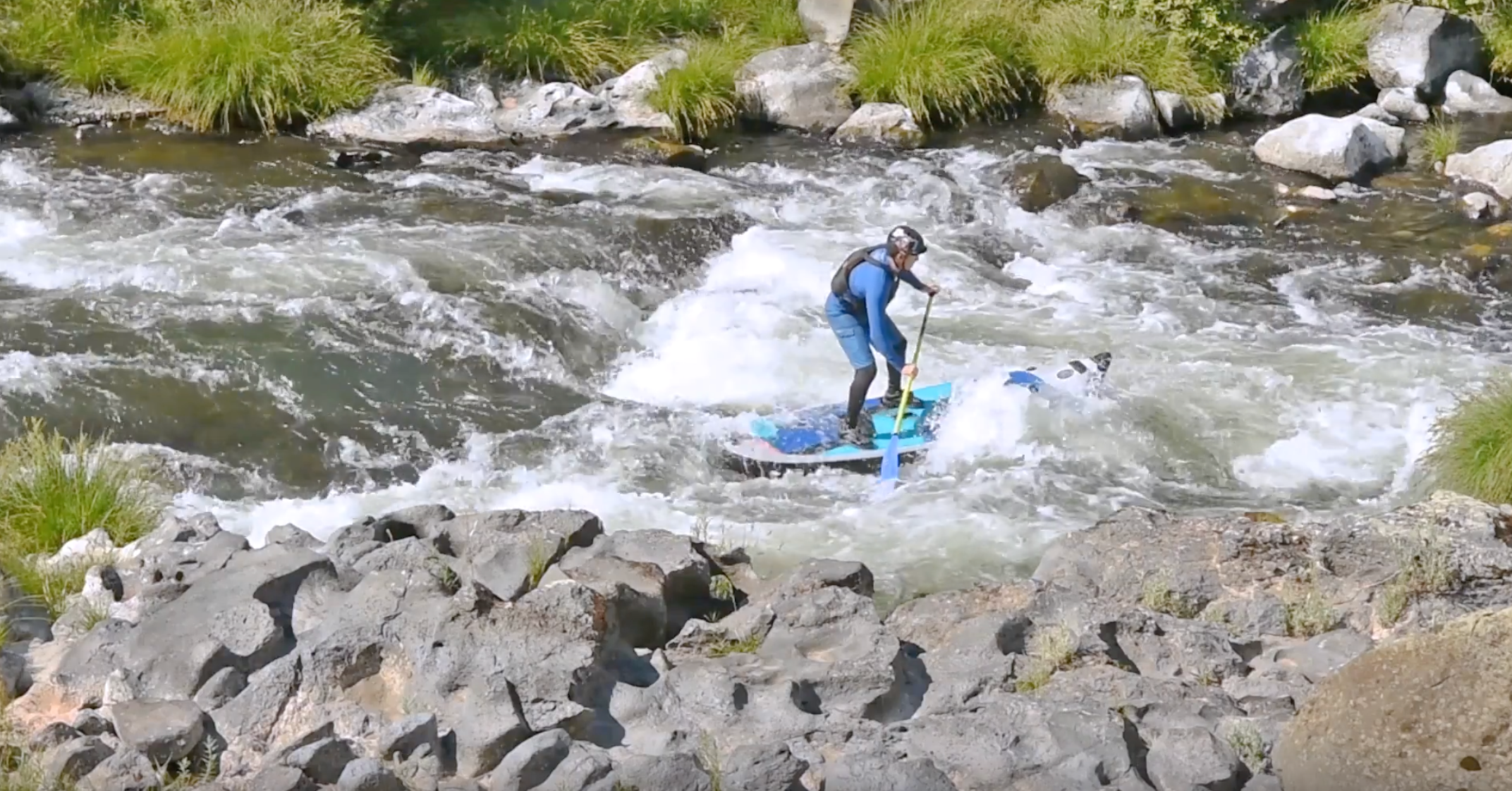
Paddleboarding the Rio Grande Wilderness
“I hope you brought patch kits!” Fred yelled to us as he watched us unroll our Hala inflatable stand-up paddleboards in his yard on the riverbank.
The five brand-new boards had never been out of the box, much less seen whitewater. Similarly, out of our crew of five, only two of us―Louis and myself―had ever been whitewater paddleboarding, on a short four-hour cruise down the Colorado River. Audra had done some flatwater paddling the summer before, while Malee tried it once in Florida on a vacation. And Mat had never seen a SUP before in his life.
Our goal: an unsupported five-day, 83-mile SUP expedition down the Rio Grande. Specifically, we would be paddling on the rapid-studded Lower Canyons section of the river, starting in La Linda, Texas and finishing in Dryden, Texas. This remote wilderness is one of only a handful of waterways in the US that are pristine and untouched enough to be designated Wild and Scenic rivers. Our plan may have been wildly ambitious (or downright crazy, depending on your perspective), but our group had a history of annual adventures that sometimes test our limits.
Planning the Trip
Our plans for the trip developed over extensive group texting over the winter, as well as a lot of research (online and by phone). It wasn’t lost on us that we were proposing going to a very remote, very wild place where there isn’t a huge margin of error.
There is certainly nothing out there about paddling the Rio Grande on a SUP, but people do it often enough on kayaks or canoes. We consulted the National Park Service website and others like American Whitewater and Southwest Paddler, which proved invaluable. We also had to secure a backcountry use permit and make sure we were familiar with all the river regulations.
Based on our research, we also started work on gear lists. First, of course, was to line up some boards; Louis and I had encountered Hala inflatable boards when taking an off day from a climbing trip in Colorado. Built in Steamboat Springs, they are designed specifically with river running in mind, so they seemed the obvious choice.
Packing light was big concern since our ability to carry gear was fairly limited. On the other hand, we were going to be on our own in the wilderness, so we had to be prepared for just about anything. Here’s a fairly comprehensive list of what we ended up bringing along: Packing List for SUP River Trip
Expedition Diary
After long drives from Minnesota (Mat, Audra, and I) and Salt Lake City (Louis and Malee), we converged in a WalMart parking lot in north central Texas in early March. From there, we continued on to what would ultimately be our final destination … Nowhere. Actually, Dryden Texas, but it sure felt like the middle of nowhere; we made sure to gas up at every station we passed, just in case.
Once in Dryden we followed our directions along long stretches of empty gravel roads to John’s Marina, which would be our take-out point at the end of the trip and where we would leave one car. Meaning we had to load every single piece of gear that we would need for the trip into the other car: five people, five SUPs, five paddles, five helmets, five of everything. Finally, after checking that we had locked Audra’s car and had her keys with us, we started the four-hour drive through more nothing to La Linda, located just outside Big Bend National Park.
We eventually made it before nightfall to Heath Canyon Ranch, near our put-in point on the river and where we would camp that night. Fred, the caretaker and a Navy retiree, was a wealth of information, telling us things we wanted to know … and a few things we didn’t. Apparently drug cartels ARE in the area (sorry, Mom!). And we should have brought more beer (we weren’t following the case-per-person-per-day formula), and we probably wouldn’t make it on our silly inflatables. Regardless, as night fell we prepped the boards and our gear, dividing out the food, the equipment, and the portable toilet. We filled our water reservoirs from Fred’s hose, made our first of many freeze-dried Mountain House meals, and fell asleep eager to rise early and start our journey.
Day One
The first day was a pretty easy paddle and was a chance to find out what we could expect daily. Once out of the canyons we were able to make some headway on the flatwater sections of the river; throughout the day we felt out how our boards handled in different sections of high and low water, as well as in the wind.
The true test, though, awaited us at mile 11.2: the Class II Maravillas rapid.It would be our first rapid of the trip and the first rapid three of the team would ever see on a SUP. We finally rounded a bend to the sight of a few larger boulders with a series of waves―as it turned out, nothing we couldn’t handle. The group went through one at a time, some standing, some kneeling. All survived without any wipeouts, boosting our confidence for the rest of the trip.
If you’re wondering, navigating whitewater on a stand-up paddleboard requires a slightly staggered stance with feet shoulder width apart. It’s important to stay centered on the board and to keep your paddle blade in the water, either paddling or using it as leverage to maintain your balance. If you feel like you are about to fall, drop to knees, and if you do fall in, never try to stand up but float your way out of the rapid and swim to the boat. Our standard procedure at whitewater was to run rapids one at a time, after scouting them beforehand.
After traveling a few miles downriver we came upon what seemed like a suitable campsite. We pulled up on shore, set up camp, and got our first fire going in the pan to boil water for a much-needed meal. As it turned out, firewood was plentiful along the shore and we ended up not using our camp stoves the entire trip. Following dinner, we made our first drinks of the trip (while we had neglected to bring beer, we had followed the one-bottle-per-person rule for cocktail supplies) and watched the clouds break and the sun set over the spectacular desert and canyons around us.
Day Two
We woke early and packed up camp. Most of our time in the mornings was spent packing our gear, distributing it among the group, and balancing the loads on the boards; each one carried around 50 pounds of gear, so this was no small task.
This day brought more rapids along with a few wipeouts, but all and all a great day, at least until we hit what would be our only foul weather of the trip—a short, very intense squall that had us clinging to mangroves on the side of the river for dear life. But it was over quickly and we continued on to our campsite for the night to enjoy another sunset on the canyon walls and a night of absolute quiet and perfect solitude.
Day Three
The third day was the shortest one mileage-wise, 17.86, but was the most densely packed with rapids. By that point, we all were starting to look forward to each one and the challenges it would bring. Even Mat and Malee had started standing up as they paddled through whitewater.
Day 3 was also the day that the sunscreen ran out. Being from the Midwest we weren’t exactly bronzed gods to begin with, and I don’t think Mat’s calves will ever be the same again. Neither will the rest of us, after coming around a bend to the sight of him paddling away naked with his shorts pulled down to cover his scorched calves.
Day Four
We woke to the sound of Rodeo Rapids, above which we’d camped; only Mat and Justin were up for running them, while the rest of us stuck closer to shore. The river continued on to our most anticipated rapid at Upper Madison Falls (Class IV). The Falls is a two-part rapid, with the second part being the more difficult drop. Everyone on the team successfully ran the first section without scouting; we then pulled off to have a snack and take a look at the second section with the drop. With the low current flow there was no runable option, so we had to ‘line’ the boats along the side, which involved connecting them bow to stern and walking them along the side of the river.
During this process we encountered the only living beings (aside from cows) we would see on the trip: two park rangers. After we’d cleared the rapid they pulled off and asked us to join them for an equipment inspection. As with most locals and rangers we met, a group on paddleboards was an entirely new thing for them. We passed the inspection with flying colors, with the exception of the required extra paddle per person (we swear it said one paddle per group …). This also provided us the opportunity to get the only group picture of the entire river section of the trip.
Day Five
As we readied our boards that morning, we wondered if it might be our last time doing so—we weren’t sure we’d be able to make the last 20.3 miles in one day. By then, the idea of arriving in Dryden in time to start making headway for home was very appealing, as much as we were enjoying both the adventure on the river and the scenery surrounding it.
San Francisco Rapid (Class II+) proved to be a little challenging at a lower flow as the river runs into a bedrock wall and makes a hard turn to the right. We all had a hard time with this one, and nearly everyone got to go for a little swim.
We made excellent time (3.3mph average) and after a little over six hours we turned a corner and saw the flow meter that we knew signaled the end of the journey―well, at least the river part. After a round of high fives and began the hard work of loading Audra’s car for the drive back to Fred’s to recover the Xterra. On the way we stopped at the one gas station for fuel and much-desired food, and, most importantly, cold beer.
Looking back on this trip, I think we all left with a great respect for the river and pride in ourselves. We were completely self-sufficient and solved each problem along the way without the use of any website or cell phone (coverage in that area is nonexistent). We trusted our maps, each other, and our gear. Speaking of which, our boards were the true champions; we never had to add air or use the patch kit, even after dragging each board across countless rocks and boulders.
I can’t help but think about returning to the Rio to give it another try, and I know I’m not the only one in our group. Maybe we’ll add some mileage and a few more rapids―I think we’ll all be up for the challenge.
Post written by Jason Ratzlaff for Backcountry.com



Leave a comment
This site is protected by hCaptcha and the hCaptcha Privacy Policy and Terms of Service apply.